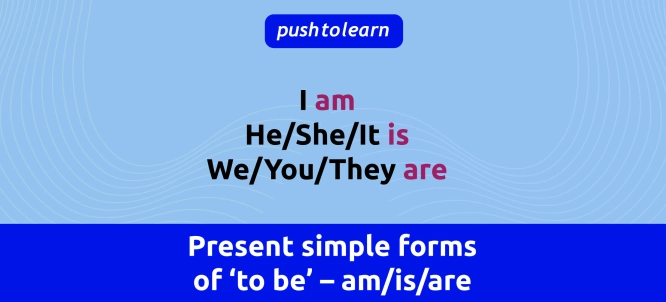by PushtoLearn
Present Simple Forms of "To Be" – Am / Is / Are
Table of Contents
To Be in Present Simple - Exercises and Quiz
These exercises focus on different forms of To Be in Present Simple
TLDR
"Am" → I
"Is" → He, She, It
"Are" → You, We, They
For negatives, add "not"
For questions, switch the subject and verb

Present Simple Forms of "To Be"
|
Subject |
Verb "To Be" |
Example |
|
I |
am |
I am a student. |
|
He / She / It |
is |
She is my friend. |
|
You / We / They |
are |
They are happy. |
Tip: The form of "to be" changes depending on the subject.
How to Use "Am / Is / Are"
For Identity & Personal Information
-
I am a teacher.
-
She is from Canada.
-
They are my classmates.
For Descriptions & Characteristics
-
The sky is blue.
-
You are very kind.
-
He is tall.
For Locations
-
I am at home.
-
The books are on the table.
-
She is in the office.
For Feelings & Conditions
-
We are tired.
-
He is sick.
-
I am happy today.
Tip: The verb "to be" is not followed by another verb in the Present Simple.
Negative Form of "To Be"
To make a sentence negative, add "not" after the verb "to be".
|
Subject |
Negative Form |
Example |
|
I |
am not |
I am not a doctor. |
|
He / She / It |
is not (isn’t) |
She is not at home. / She isn’t at home. |
|
You / We / They |
are not (aren’t) |
They are not ready. / They aren’t ready. |
Tip: "Is not" → "isn’t" and "are not" → "aren’t" are common contractions.
Questions with "To Be"
To form questions, switch the subject and the verb "to be".
|
Statement |
Question |
|
You are a teacher. |
Are you a teacher? |
|
She is happy. |
Is she happy? |
|
They are at home. |
Are they at home? |
Yes/No Questions:
-
Are you from France? → Yes, I am. / No, I’m not.
-
Is she your sister? → Yes, she is. / No, she isn’t.
Wh- Questions:
-
Where is your book? → It is on the table.
-
How are you? → I am fine.
See also Question Forms and Special Questions.
Common Mistakes with "To Be"
|
Mistake |
Incorrect |
Correct |
|
Missing "to be" |
She happy. |
She is happy. |
|
Using "do/does" with "to be" |
Does she is a doctor? |
Is she a doctor? |
|
Using wrong form |
They is my friends. |
They are my friends. |
Tip: NEVER use "do" or "does" with "to be"!
FAQ: Common Questions About "To Be"
Can I use "am not" in questions?
No! Instead, use "Aren’t I?"
WRONG: Am I not your friend?
CORRECT: Aren’t I your friend?
What is the contraction of "I am"?
"I’m"
I’m happy.
Can I say "I amn’t"?
No! Say "I’m not."
Can I use "to be" with another verb?
No! In the Present Simple, "to be" is not followed by another verb.
WRONG: She is study English.
CORRECT: She is a student.
How do I make a negative question?
Aren’t / Isn’t at the beginning.
- Isn’t she your teacher?
- Aren’t they coming?

